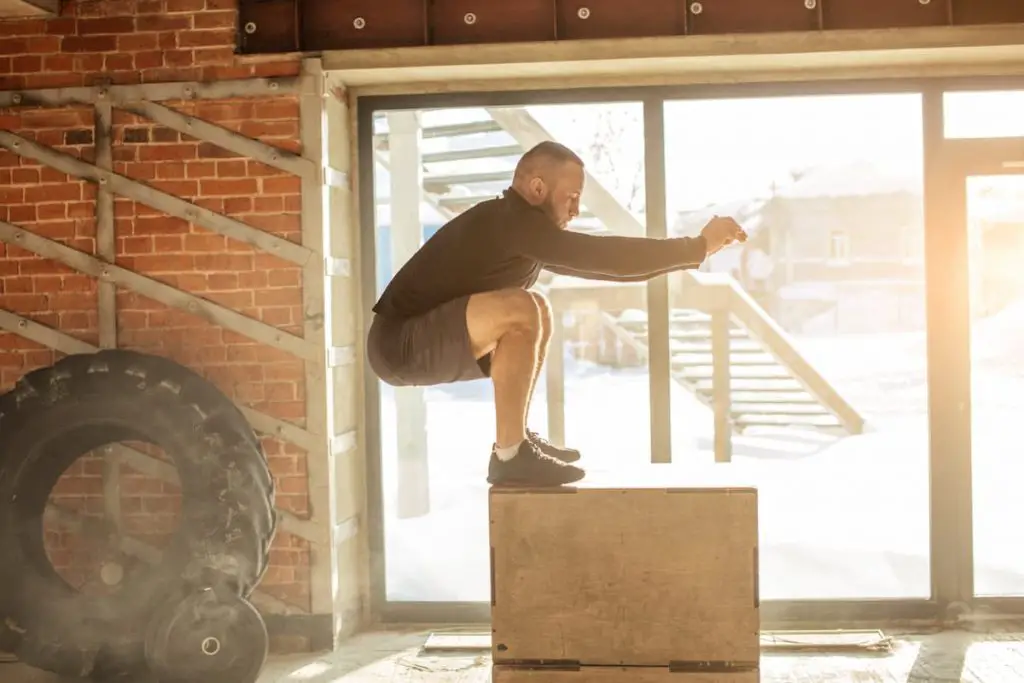For anyone looking to participate in sports that require powerful legs and jumping the vertical jump is a core need to develop. The vertical jump is also one of the simplest tests of measuring how much power an athlete can generate, so what is considered a good vertical jump?
A good vertical jump for a fully-grown adult male would be higher than 24″ to be considered a good height. For a woman, a vertical jump over 20″ is considered a good height. For many their starting numbers will be lower than this normal without specific training.
Although the ranges that were specified are good for a vertical jump, professional athletes will still far exceed these numbers. Due to it being such an important measurement of power and endurance, we have a program called Vert Shock that helps to achieve great results for your vertical jump.
Why is a Good Vertical Jump so Important?
A good vertical jump is so important because of what it is a measurement of. It will measure the athletes raw power output and stamina. Not only that, but the skill itself can be incredibly useful in a wide variety of sports.
Almost every single athlete in every single sport can benefit from this skill, whether it be from the jumping height advantage or from the extra power and muscle in the legs that will allow you to gain an advantage in whatever your sport may be.
The vertical jump will be a good sign to a coach in a sport that the athlete they are dealing with is one who possesses all of the traits that they require.
Power, speed and quickness are all valuable assets for a coach to be able to observe and there’s no better yardstick of measurement than the vertical jump.

History of the Vertical Jump
Interestingly, the vertical jump also goes by another name. That name is the Sargent jump. The reason for the obscure name is because the jump was named after Dudley Allen Sargent.
Sargent was not only interested in his scholarly pursuits but was also interested in the teaching of physical training. Sargent was famed for combining his love of the sciences with his love of physical education, training it at the schools he taught at.
Along with this innovation, Sargent would form the Vertical Jump Test.
The Vertical Jump Test would measure the muscle power of the legs. This was done by getting the tester, while standing still initially with no counter movement to assist, jump vertically up in the air using the arms and legs to propel the body, after which the jump height would be recorded.

How to Jump Higher in 45 Minutes – The Workbook
This is now available for you to grab and get started today without waiting for any more information!
We have spend a lot of time making this VERY comprehensive and feedback has been VERY positive.
Examples of Good Vertical Jumps
The people with the best vertical jumps are NFL and NBA players. Both sports include incredibly physically powerful athletes who train day in and day out to be the very best.
Both sports also have a high degree of focus on the power of the legs and the agility, power and endurance required by a vertical jump. Due to the fact that they train to be as powerful and strong as possible, NFL players have some of the best vertical jumps.
In fact they hold almost every single vertical jump record that there is, reaching over 46” in their vertical jump. This is a number that is almost double of what would be considered ‘good’ for a normal person.
How to Correctly Perform a Vertical Jump
Even though it would seem as if it would be simple to perform a vertical jump, it’s not as easy as just jumping up and down. Athletes all specifically learn how to do this jump and it is often what will separate them from someone who is otherwise fairly fit.
The first step is to adopt a stance where your feet are far enough apart that your legs are straight up and down to your hips. After this, you should bend your knees until you are at a point that you feel you are ready to spring.
The next part should be simple enough, you have to jump with all of your power, like you are trying to push away from the floor, remember to breathe out as you leap.
What you do with your arms here is also important, as you must remember to keep them straight but throw them in the air to assist with momentum for your big leap.
Other than that, it’s as simple as it sounds.
What Else can the Vertical Jump tell you?
The vertical jump can also be incredibly useful in informing what state of recovery you are currently in. If you have been doing excessive training, such as weigh weights, etc, then your body will essentially be “slowed down” by the fatigue.
When you attempt to do a vertical jump, which requires a great deal of explosive power and speed, you will notice a drastically decreased level of performance.
It can also be useful if you are not an athlete to measure the progress that you are making with your physical fitness, as the vertical jump will be a good summary of how you are developing your strength.
Is it Possible to Injure Yourself Doing a Vertical Jump?
While it’s not particularly inherently dangerous, it’s good to remember that when you are doing any exercise that involves the kind of explosive movement that vertical jumps do, there is a possibility of overusing a muscle or putting too much strain on a joint.
Especially in the case of these kinds of exercises, also called plyometrics, the strain is so frequent and so sudden that it can be possible to do damage. Simply be aware of your own limitations and try to understand how far is appropriate to push your own body.
Plyometrics
The vertical jump comes under a category of exercises less commonly known as plyometrics, which essentially means “jump training”. Almost all of these exercises also focus on the core ideas behind the vertical jump, the concept of increasing power as much as physically possible.
Power is regarded as being the combination of strength and speed, the art of learning to contract and extend your muscles in as explosive a manner as possible.
In a similar style to vertical jumps, plyometrics are an exercise common to all professional athletes at every level, prized for their ability to build power relatively safely.
Most of all they do this without the need for dangerous equipment or unnecessary external strain on the body, meaning that a professional athlete will be able to work injury free whilst making progress.
Athletes may even choose to perform these exercises whilst under a heavy load. An example would be to perform some of these jump exercises whilst holding dumbbells.
The Vert Shock program though, prefers no weights to the other alternative that would would be weighted clothing, which while less common is still a viable option.
What are Some Other Plyometrics Exercises?
Almost all of the other plyometrics, like the name suggests, involving jumping in some form or another. One of the most commonly known is the “box jump”. Similar to the vertical jump, you jump high into the air and land on a box, testing both your power and your agility.
One of the few plyometric exercises that have nothing to do with jumping is the plyometric push-up. This is a push-up where you use enough force that you are able to clap your hands before the completion of the return fall.
Final Thoughts on What is Considered a Good Vertical Jump
In the end a successful athlete will almost always need to be able to generate massive power through their legs to jump and block shots, take shots, dunk, spike, and so much more.
While a vertical jump is incredibly useful many people overlook it for weights and pure strength but the only way to get better at jumping is to practice and work at jumping.
We love the Vert Shock system as it offers a vast trove of amazing information, drills, and strategies to jump high fast and it is proven through numerous user testimonials.
They offer a TOTALLY FREE ebook to start learning to jump higher starting today, this minute, delivered to your email so you can start reading and working on your abilities immediately!








